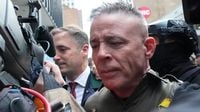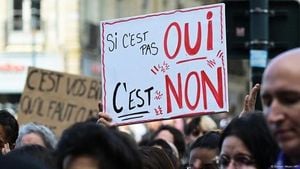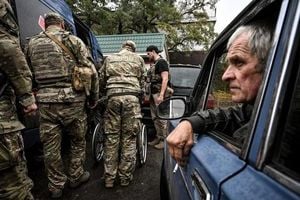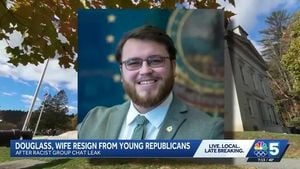On a brisk Tuesday morning in late October 2025, the marble halls of Chicago’s Dirksen Federal Courthouse buzzed with anticipation. U.S. Border Patrol Commander Gregory Bovino, the face of the Trump administration’s controversial “Operation Midway Blitz,” appeared before U.S. District Judge Sara Ellis to answer for a series of aggressive immigration raids and the use of tear gas against protesters and bystanders—including children—in neighborhoods across the city.
The hearing, prompted by a lawsuit filed by a coalition of media organizations, focused on the federal agents’ treatment of protesters and journalists during ongoing immigration enforcement operations. Tensions have run high in Chicago since early October, as federal agents, led by Bovino, deployed tear gas in Little Village, Lakeview, and Old Irving Park—often without the two warnings required by a standing court order. According to WTTW News, these actions have triggered outrage both locally and nationwide, as videos of the confrontations flooded social media.
Judge Ellis made her position clear from the outset. After reading aloud the temporary restraining order she had issued more than two weeks prior, she told Bovino, “It is difficult for me to see that the force being used is necessary to stop an immediate and serious threat of physical harm to a person.” She added, “Kids dressed in Halloween costumes, walking to a parade, do not pose an immediate threat to the safety of a law enforcement officer. They just don’t.”
Over the next hour and fifteen minutes, Ellis grilled Bovino about compliance with her orders. She questioned the necessity of force in several incidents, particularly one in Old Irving Park where children celebrating Halloween were caught in clouds of tear gas. “Their sense of safety was shattered,” Ellis remarked, her frustration palpable. “It is going to take a long time to come back, if ever.”
Bovino, known for his brash social media presence and frequent media appearances, responded quietly to the judge’s pointed questions. When asked if agents were following the court’s mandate to give two warnings before deploying tear gas, he replied, “I understand what you are saying, your honor. We will abide by the temporary restraining order.”
That wasn’t enough for Ellis, who ordered Bovino to report to her chambers in person every weekday at 6 p.m. until a preliminary injunction hearing scheduled for November 5. She also insisted that Bovino himself obtain and wear a body-worn camera by Friday, October 31, and that all agents under his command display their identification numbers in at least two conspicuous locations on their uniforms. “The camera is your friend,” Ellis told Bovino, emphasizing that video evidence would clarify disputed events and ensure accountability.
Ellis demanded that all use-of-force reports and body-worn camera footage dating back to September 2 be delivered to her by the end of the week. Any new incidents would need to be reported within 24 hours. While the government’s lawyers protested that assembling such documentation on short notice would be “physically impossible,” Ellis was firm but reasonable, granting them until week’s end to comply.
The judge also addressed the pending motion to ban tear gas outright. She neither granted nor denied the request, choosing instead to hold it in reserve. “If they are using tear gas, they better be able to back it up,” she warned. “And if they can’t, then they will lose that as something they can use.” Ellis made it clear she expected good faith from all parties, but she was prepared to enforce her order if necessary.
Chicago Mayor Brandon Johnson, who has been outspoken in his criticism of the federal raids, weighed in during his weekly press conference. He described Bovino as a “barbaric individual” and said the regular court appearances ordered by Judge Ellis were “a start in the right direction.” Still, Johnson expressed deep skepticism that any measure short of halting the raids would address his concerns. “It’s a start. I don’t know if there’s anything that’s going to assuage my apprehension or even, quite frankly, my rejection of their approach simply because it has been incredibly gruesome,” he told reporters, according to the Chicago Sun-Times.
Throughout the hearing, Ellis stressed the importance of protecting journalists and the right to protest. She reminded Bovino that the temporary restraining order specifically forbids interference with journalists lawfully covering the events. “Section 1A means, essentially, that you’ve got to leave journalists alone. If they’re doing their job, they need to be left alone to do their job,” she said.
Ellis also recounted harrowing details from recent incidents. In one, a woman in Little Village was pulled to the ground and pinned by an agent’s knee, despite video evidence showing she posed no immediate threat. In another, a federal officer—without a visible body camera or identification—shot a protester in the neck with a pepper ball from five feet away. As the agents left, they reportedly pointed weapons at a bystander, a combat veteran, and taunted him. “On its face, that violates the TRO,” Ellis said, referencing the court’s temporary restraining order.
For his part, Bovino acknowledged that about 99% of agents have body-worn cameras, though he cited ongoing equipment distribution issues. He promised to ensure that all agents operating under Operation Midway Blitz would be properly equipped, and agreed to the judge’s request to personally wear a camera. When pressed about agent identification, Bovino agreed to make the display of badge numbers more conspicuous, settling on at least two visible locations on each uniform.
As for the government’s stance, lawyers argued that the use of tear gas was sometimes necessary to ensure agent safety in “highly volatile situations.” However, the plaintiffs countered that federal agents were “proactively throwing tear gas at civilians,” thereby escalating tensions and justifying further force.
Judge Ellis concluded the hearing by reiterating her commitment to the law. “My role is not to tell you that you can or cannot enforce validly passed laws by Congress. That’s not my role. … My role is simply to see that any enforcement of those laws is done in a manner that is consistent with your obligations under the law,” she said.
As Bovino left the courthouse, protesters outside waved signs reading “Stop ICE Brutality” and “Welcome Immigrants,” a reminder of the deep divisions and high stakes surrounding immigration enforcement in Chicago. With daily court check-ins and increased scrutiny, both the city and the nation will be watching closely as the case moves toward its next hearing on November 5. For now, Judge Ellis’s orders have set a new tone of accountability—one that federal agents, city officials, and Chicago residents alike cannot afford to ignore.




